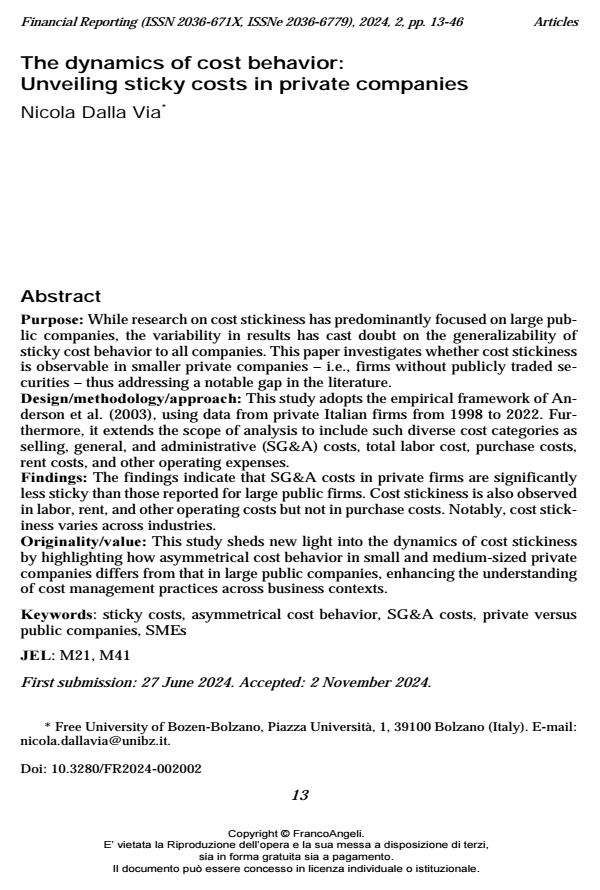The dynamics of cost behavior: Unveiling sticky costs in private companies
Titolo Rivista FINANCIAL REPORTING
Autori/Curatori Nicola Dalla Via
Anno di pubblicazione 2024 Fascicolo 2024/2
Lingua Inglese Numero pagine 34 P. 13-46 Dimensione file 280 KB
DOI 10.3280/FR2024-002002
Il DOI è il codice a barre della proprietà intellettuale: per saperne di più
clicca qui
Qui sotto puoi vedere in anteprima la prima pagina di questo articolo.
Se questo articolo ti interessa, lo puoi acquistare (e scaricare in formato pdf) seguendo le facili indicazioni per acquistare il download credit. Acquista Download Credits per scaricare questo Articolo in formato PDF

FrancoAngeli è membro della Publishers International Linking Association, Inc (PILA)associazione indipendente e non profit per facilitare (attraverso i servizi tecnologici implementati da CrossRef.org) l’accesso degli studiosi ai contenuti digitali nelle pubblicazioni professionali e scientifiche
Purpose: While research on cost stickiness has predominantly focused on large public companies, the variability in results has cast doubt on the generalizability of sticky cost behavior to all companies. This paper investigates whether cost sticki-ness is observable in smaller private companies – i.e., firms without publicly traded securities – thus addressing a notable gap in the literature. Design/methodology/approach: This study adopts the empirical framework of Anderson et al. (2003), using data from private Italian firms from 1998 to 2022. Furthermore, it extends the scope of analysis to include such diverse cost catego-ries as selling, general, and administrative (SG&A) costs, total labor cost, purchase costs, rent costs, and other operating expenses. Findings: The findings indicate that SG&A costs in private firms are significantly less sticky than those reported for large public firms. Cost stickiness is also ob-served in labor, rent, and other operating costs but not in purchase costs. Notably, cost stickiness varies across industries. Originality/value: This study sheds new light into the dynamics of cost stickiness by highlighting how asymmetrical cost behavior in small and medium-sized pri-vate companies differs from that in large public companies, enhancing the under-standing of cost management practices across business contexts.
Parole chiave:sticky costs, asymmetrical cost behavior, SG&A costs, private versus public companies, SMEs
Jel codes:M21, M41
- Economic uncertainty and the acquisition of private companies in Europe Luca Viarengo, in FINANCIAL REPORTING 2/2025 pp.249
DOI: 10.3280/fr202519871 - Unintended consequences of tax incentives on the accounting quality of private firms Massimiliano Bonacchi, Luca Menicacci, in FINANCIAL REPORTING 2/2025 pp.91
DOI: 10.3280/fr202519445
Nicola Dalla Via, The dynamics of cost behavior: Unveiling sticky costs in private companies in "FINANCIAL REPORTING" 2/2024, pp 13-46, DOI: 10.3280/FR2024-002002